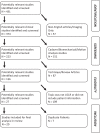Ulnar Collateral Ligament Reconstruction of the Elbow: A Systematic Review of the Literature
- PMID: 26740956
- PMCID: PMC4687831
- DOI: 10.1177/2325967115618914
Ulnar Collateral Ligament Reconstruction of the Elbow: A Systematic Review of the Literature
Abstract
Background: Ulnar collateral ligament reconstruction (UCLR) is a common procedure in both professional and high-level athletes.
Purpose: To determine the effect of technique and level of play with UCLR on return to sport (RTS).
Hypothesis: When comparing different surgical techniques or preoperative level of sports participation, there is no difference in rate of RTS after UCLR.
Study design: Systematic review; Level of evidence, 4.
Methods: A systematic review was registered with PROSPERO and performed following PRISMA (Preferred Reporting Items for Systematic reviews and Meta-Analyses) guidelines using 3 publicly available free databases. Therapeutic clinical outcome investigations reporting UCLR outcomes with level of evidence 1 through 4 were eligible for inclusion. All study, subject, and surgical technique demographics were analyzed and compared between continents and countries. Descriptive statistics were calculated, and 2-proportion 2-sample z-test calculators with α = .05 were used to compare RTS between level of play and technique.
Results: Twenty studies (2019 patients/elbows; mean age, 22.13 ± 4 years; 97% male; mean follow-up, 39.9 ± 16.2 months) were included. The majority of patients were baseball players (94.5%), specifically pitchers (80%). The most common level of play was collegiate (44.6%). Palmaris longus (71.2%) and the American Sports Medicine Institute (ASMI) technique (65.6%) were the most common graft choice and surgical technique, respectively. There was a pooled 86.2% RTS rate, and 90% of players scored excellent/good on the Conway-Jobe scale. RTS rates were higher among collegiate athletes (95.5%) than either high school (89.4%, P = .023) or professional athletes (86.4%, P < .0001). RTS rates were higher for the docking technique (97.0%, P = .001) and the ASMI technique (93.3%, P = .0034) than the Jobe technique (66.7%).
Conclusion: UCLR is performed most commonly in collegiate athletes. Collegiate athletes have the highest RTS rate after UCLR of all levels of competition. The docking and ASMI techniques had higher RTS rates than the Jobe technique.
Keywords: Tommy John; baseball; elbow; pitcher; return to sports (RTS) rate; ulnar collateral ligament (UCL) reconstruction.
Conflict of interest statement
One or more of the authors has declared the following potential conflict of interest or source of funding: N.N.V. receives research support from Arthex, Arthrosurface, DJ Orthopaedics, Smith & Nephew, Athletico, Conmed Linvatec, Miomed, and Mitec; holds stock or stock options in Cymedica, Minivasive, and Omeros; is a paid consultant for Minivasive and Smith & Nephew; and receives royalties from Smith & Nephew and Vindico Medical-Orthopedics Hyperguide. A.A.R. receives royalties from Arthex and SLACK Inc; receives research support from DJO Surgical, Ossur, and Smith & Nephew; and is a paid consultant for Arthrex.
Figures




References
-
- Ahmad CS, Grantham WJ, Greiwe RM. Public perceptions of Tommy John surgery. Phys Sportsmed. 2012;40:64–72. - PubMed
-
- Alberta FG, ElAttrache NS, Bissell S, et al. The development and validation of a functional assessment tool for the upper extremity in the overhead athlete. Am J Sports Med. 2010;38:903–911. - PubMed
-
- Andrews JR, Timmerman LA. Outcome of elbow surgery in professional baseball players. Am J Sports Med. 1995;23:407–413. - PubMed
-
- Azar FM, Andrews JR, Wilk KE, Groh D. Operative treatment of ulnar collateral ligament injuries of the elbow in athletes. Am J Sports Med. 2000;28:16–23. - PubMed
-
- Bowers AL, Dines JS, Dines DM, Altchek DW. Elbow medial ulnar collateral ligament reconstruction: clinical relevance and the docking technique. J Shoulder Elbow Surg. 2010;19(2 suppl):110–117. - PubMed
LinkOut - more resources
Full Text Sources
Other Literature Sources
Medical

